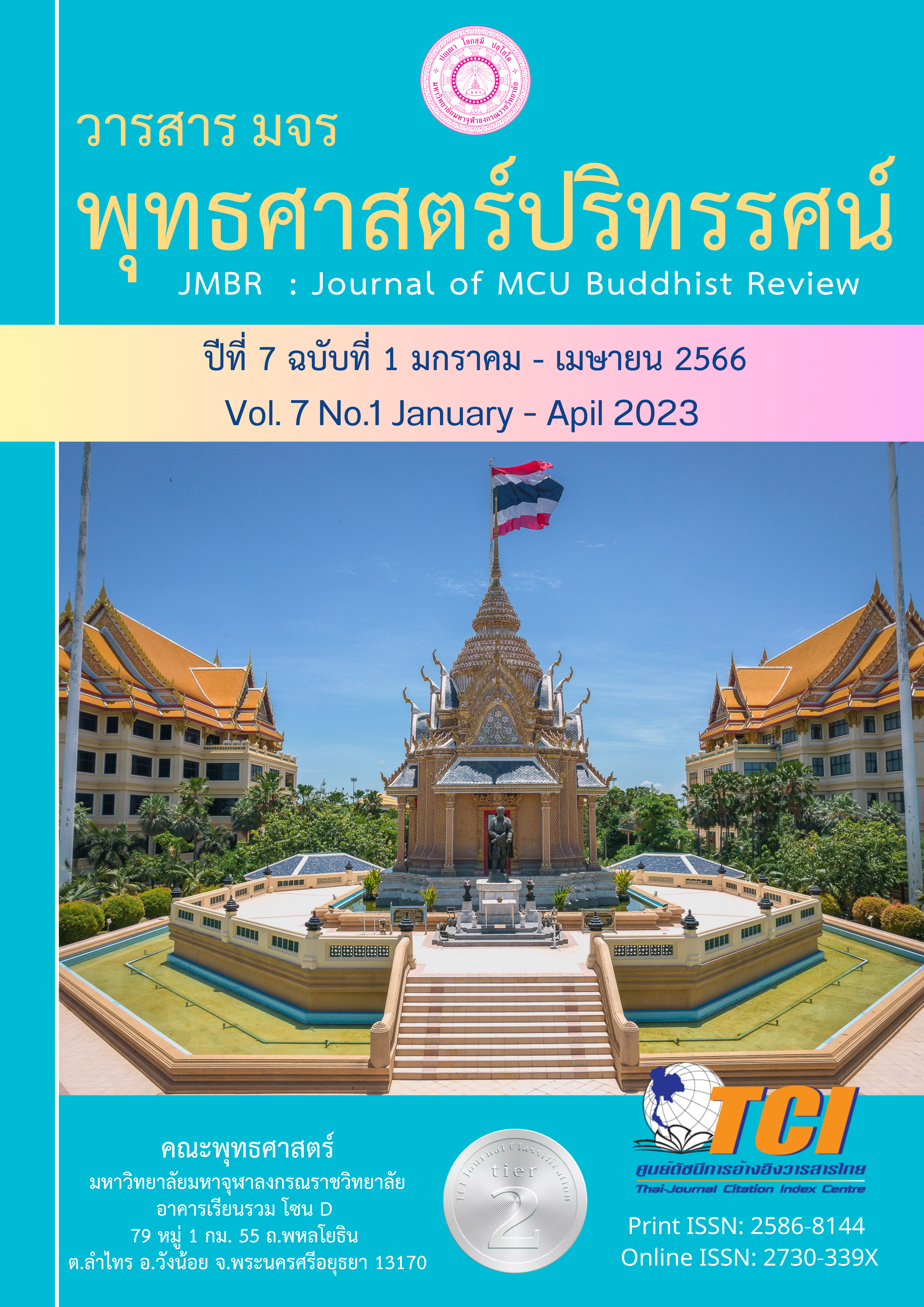การปฏิบัติธรรมตามแนวมหาสติปัฏฐานสูตร
Main Article Content
บทคัดย่อ
การปฏิบัติวิปัสสนากรรมฐานตามแนวมหาสติปัฏฐานสูตรมีการสั่งสอนสืบทอดมาตามลำดับ เป็นเวลานับด้วยสองพันกว่าปี ในยุคต่อมาพระธรรมธีรราชมหามุนี (โชดก ญาณสิทฺธิ) ได้ก่อตั้งการปฏิบัติวิปัสสนากรรมฐาน สายพอง-ยุบ ในประเทศไทย เป็นพัฒนาการในการสอนตามแนวมหาสติปัฏฐานสูตร ที่มีการประยุกต์หลักการหายใจและอิริยาบถต่างๆ มาเป็นวิธีปฏิบัติที่มีคำบริกรรมว่า หนอ เป็นการเจริญสติตามแนวสติปัฎฐาน 4 สำนักปฏิบัติวิปัสสนาที่เป็นศิษยานุศิษย์ของพระธรรมธีรราชมหามุนี (โชดก ญาณสิทฺธิ) ได้เปิดตัวออกมามากมาย ในการศึกษากรณีสำนักปฏิบัติวิปัสสนาที่เป็นศิษยานุศิษย์ พบว่าทุกแห่งมีการพัฒนาหลักสูตรการสอน และวิธีปฏิบัติที่แตกต่างกันไปแต่ก็ยังยึดมั่นในการสอนตามหลักมหาสติปัฏฐานสูตร มีพัฒนาการด้วยการประยุกต์การบริกรรมพองหนอ ยุบหนอ เข้ากับวิธีการที่เป็นนวัตกรรมของตน
Article Details

อนุญาตภายใต้เงื่อนไข Creative Commons Attribution-NonCommercial-NoDerivatives 4.0 International License.
- บทความที่ได้รับการตีพิมพ์เป็นลิขสิทธิ์ของวารสาร มจร พุทธศาสตร์ปริทรรศน์
- ข้อความใดๆ ที่ปรากฎในบทความที่ได้รับการตีพิมพ์ในวารสาร ถือเป็นความรับผิดชอบของผู้เขียนบทความ และข้อคิดเห็นนั้นไม่ถือว่าเป็นทัศนะและความรับผิดชอบของกองบรรณาธิการวารสาร มจร พุทธศาสตร์ปริทรรศน์
เอกสารอ้างอิง
จำรูญ ยาสมุทร. (2552). คู่มือการปฏิบัติวิปัสสนากรรมฐานตามแนววิปัสสนาวงศ์พระอรหันต์. เชียงใหม่ : ชมรมเผยแพร่พระพุทธศาสนา.
ธนิต อยู่โพธิ์. (2548). แปลและเรียบเรียง. วิปัสสนานิยม. กรุงเทพมหานคร: มหาจุฬาลงกรณราชวิทยาลัย.
เปลื้อง ณ นคร. (2538). พจนานุกรม แปล ไทย-ไทย. กรุงเทพมหานคร: สำนักพิมพ์ไทยวัฒนาพานิช.
พระกอบชัย เขมจารี. (2561). วิธีการสอนวิปัสสนาภาวนา: กรณีศึกษาพระมหาปาน อานนฺโทวัดมหาพุทธ วงศา ป่าหลวง นครเวียงจันทน์ สาธารณรัฐประชาธิปไตยประชาชนลาว. วิทยานิพนธ์พุทธศาสตรมหาบัณฑิต คณะพุทธศาสตร์: มหาจุฬาลงกรณราชวิทยาลัย.
พระครูประสาทสังวรกิจ. (2543). ธรรมะภาคปฏิบัติ. กรุงเทพฯ: โรงพิมพ์มหาจุฬาลงกรณราชวิทยาลัย
พระธรรมธีรราชมหามุนี (โชดก ญาณสิทฺธิ). (2523). ความสำคัญของคำว่าหนอ. กรุงเทพมหานคร: วัดมหาธาตุ ยุวราชรังสฤษฏ์.
พระพุทธโฆสาจารย์. (2548). คัมภีร์วิสุทธิมรรค. กรุงเทพฯ: โรงพิมพ์มหามกุฏราชวิทยาลัย.
พระพรหมคุณาภรณ์ (ป.อ. ปยุตฺโต). (2551). พุทธธรรม. กรุงเทพฯ: บริษัทสหธรรมิกจำกัด.
พระพรหมคุณาภรณ์ (ป.อ. ปยุตฺโต). (2547). การปฏิบัติธรรม. นครปฐม: วัดญาณเวศกวัน.
พระพรหมคุณาภรณ์ (ป.อ. ปยุตฺโต). (2548). พระพุทธศาสนาในเอเชีย. พิมพ์ครั้งที่ 5. กรุงเทพฯ: ธรรมสภา.
พระพรหมโมลี (วิลาศ ญาณวโร). (2543). วิปสสนาวงศ์. กรุงเทพฯ: สํานักพิมพดอกหญา.
พระสัทธัมมโชติกะ ธัมมาจริยะ. (2554). สมถกรรมฐานทีปนี. พิมพ์ครั้งที่ 6. กรุงเทพฯ: บริษัท วี.อินเตอร์ พริ้นต์ จำกัด.
พระโสภณมหาเถระ (มหาสี สะยาดอว์). (2549). มหาสติปัฏฐานสูตร ทางสู่พระนิพพาน. แปลโดย พระคันธสาราภิวงศ์. กรุงเทพฯ: ห้างหุ้นส่วนจำกัดไทยรายวันการพิมพ์.
มหาจุฬาลงกรณราชวิทยาลัย. (2539). พระไตรปิฎกฉบับภาษาไทย ฉบับมหาจุฬาลงกรณราชวิทยาลัย. กรุงเทพฯ: มหาจุฬาลงกรณราชวิทยาลัย.
มหาจุฬาลงกรณราชวิทยาลัย. (2559). พระไตรปิฎกและอรรถกถาฉบับภาษาไทย ฉบับมหาจุฬาลงกรณราช วิทยาลัย. กรุงเทพฯ: มหาจุฬาลงกรณราชวิทยาลัย.
มหาเถรสมาคม. (2558). ระเบียบมหาเถรสมาคม. กรุงเทพฯ: มหาเถรสมาคม.
ศูนย์เผยแผ่พระพุทธศาสนาแห่งชาติ. (2558). สำนักปฏิบัติธรรมตามแนวสติปัฏฐานสูตร. นนทบุรี: ปัญญฉัตรบุ๊คส์บายติ้ง จำกัด.
สมเด็จพระพุทธโฆษาจารย์ (ป.อ. ปยุตโต.). (2564). พุทธธรรมฉบับปรับขยาย. Printed in Chaina.


